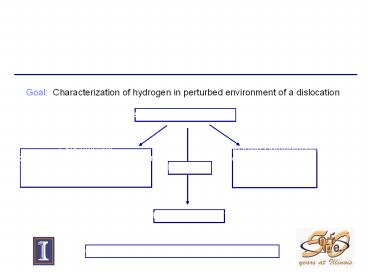Hydrogen Trapping Interactions with PowerPoint PPT Presentation
Title: Hydrogen Trapping Interactions with
1
Hydrogen Trapping Interactions with Dislocations
in Pd at Low Temperature
Brent J. Heuser
University of Illinois at Urbana-Champaign
Goal Characterization of hydrogen in perturbed
environment of a dislocation
Supported by the NSF, the ACS-PRF, and the Univ.
Illinois
2
Collaborators and Facilities
J. King (U. Michigan), G. Summerfield (U.
Michigan) E. Epperson (ANL), F. Boue (CEA
Saclay) W.C. Chen (U. Illinois, NIST), H. Ju (U.
Illinois) T. Udovic (NIST), J. Barker (NIST), C.
Glinka (NIST) D. Trinkle (U. Illinois), A. Lipson
(U. Illinois, Russian Acad. Sci.) NCNR at NIST,
Lujan Center at LANL, LLB at Saclay, IPNS at
ANL MRL at U. Illinois
3
Background
Pd-H phase diagrams
- Relevant Properties of H (D) in Pd
- Pd good catalyst for H2 ? H H.
- H is an octahedral interstitial in fcc lattice.
- elastic response due to 1s-4d hybridization.
- DV/V0.11 (100 a at RT).
- hydride formation accompanied
- by dislocation generation.
- 0.2 eV activation energy for diffusion.
- 0.7 eV trapping energy at dislocation cores.
- stoichiometric hydride phase difficult.
- b-Pd superconducting (Tc1-8 K) Pd is
- paramagnetic.
4
Neutron Scattering Instruments
- Small-angle neutron scattering
- no neutron energy loss
- measurements in Q domain
- length scales 10 to 2000 Å
- good for H (D) in metals
- clean single crystals
- Incoherent inelastic neutron scattering
- neutron energy loss or gain
- measurements in time domain
- vibrational density of states
- good for H in metals
FANS at NIST
5
Inelastic Neutron Scattering
Hydrogen Vibrational DOS in Polycrystalline
PdH0.7 (Incoherent INS)
w vs. k Phonon Dispersion Curves in Single
Crystal PdD0.63 (Coherent INS)
LO
TO
Hunt and Ross J. Less-C. Metals (1976) 169.
Rowe et al., PRL 33 (1974) 1297.
6
Vibrational Density of States
Incoherent INS Measurements (21g Pd
sheet) Deformed PdH0.0008 (0.15 mg H) b-PdH0.63
Well-annealed a-PdH0.015
Comparisions 4 K PdH0.0008 similar to
b-PdH0.63 295 K PdH0.0008 similar to
a-PdH0.015 Conclusion a?b phase transformation
at dislocations upon cooling from 295 to 4 K.
7
Peak Shift at 295 K
8
SANS Measurements of Deformed Single Crystal
PdD0.0055
Cross Section Model Cylinder of trapped
solute w/radius Ro and length Lo
J. Alloys Compd. 261 (1997) 225.
9
DFT Relaxation of an Edge Dislocation in Pd
Local Volumetric Dilatation
Circles are relaxed Pd positions
10
Magnetic Susceptibility Measurements in Deformed
PdH0.0004
Pd is paramagneticlow T tail due to Fe
impurities fit of M(H)_at_2 K to paramagnetic
Langevin function yields CFelt10appm. Deformed
PdH0.0004 has a diamagnetic behavior below 50 K
and exhibits irreversible M(H) behavior at 2 K
indicative of a Type II superconductor.
Phys. Lett. A, 339 (2005) 414.
11
Conclusions
- a?b phase transformation upon cooling 295?4 K
based on incoherent INS. - peak shape and peak location can serve as a
probe of local disorder of trapping site. - RT local concentration from SANS sufficient for
phase transformation upon cooling. - DFT calculations demonstrate large local
dilatation with addition of one H atom.
12
(No Transcript)
13
Elastic Neutron Scattering
Filling dislocation with H or D
Scattering response I ? Dr2 Scattering length
density r Natomb
r
bulk Pd
No H/D
Dr
bulk Pd
w/H
Dr
bulk Pd
Dr
w/D
x
14
(No Transcript)

